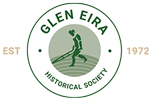History
Glen Eira is named after two landmarks; the road that runs from Brighton Road through Caulfield to the Racecourse and Henry Ricketson’s mansion in Kooyong Road, which became Australian General Hospital No. 11 during the First World War.
The history of Glen Eira is a tale of two cities that came together in 1994 when the suburbs of Ormond East, McKinnon, Bentleigh and Bentleigh East in the City of Moorabbin joined the City of Caulfield to become the new City of Glen Eira.
The Caulfield District Road Board was established in 1857 and the Moorabbin District Road Board a few years later in 1862. A history of these areas is well documented in official histories of the former City of Caulfield and the former City of Moorabbin along with various other publications listed on this website. Visit Publications and Resources
Caulfield
‘By 1850 the bush silence was beginning to be broken. The most portentous foreign sound was the crack of the drover’s whip. It startled the wildfowl on the swamps and the animals on the eastern heathlands. The sound meant that another mob of Gippsland livestock was on the move. Rested and watered in Caulfield, these prime animals would fetch a top price in Melbourne’s markets next morning.’
(Sand, Swamp and Heath…A History of Caulfield, Murray and Wells, 1980, p1)
‘Caulfield has been, for most of its history a pleasant and prestigious place to live – a district of wide tree-lined streets, of private homes in garden settings of schools and places of worship.’
(Caulfield Heritage, Geulah Solomon, 1989, p5)
Moorabbin
In the 1850s many settlers of this area were market gardeners coming from England, Scotland and Ireland. They grew vegetables and wheat, had large orchards, even grape vines were popular until they were wiped out with “blight”.
With the coming of the rail in 1884 more people were attracted to the Moorabbin area and by the 1920s land subdivision and commercial development were happening and small villages appearing.
After the Second World War, more and more houses were built, local traders established grocery shops, green-grocers, bakeries, hardware, chemists, delicatessens, butchers and milk bar/lolly shops. By the 1950s/60s large shopping strips were well established; Centre Road Bentleigh being the main one but there were still market gardens in the East Bentleigh area.
(Moorabbin: A Pictorial History 1862-1994, John Cribbin/City of Kingston, 1995)
Articles
Gardenvale Park (An idea last century; reality this century)
Caulfield’s transition from being a pastoral area, where the wealthy built their mansions far from the bustling city, to being a densely settled suburb occurred gradually but not at a constant pace. The Caulfield Roads Board was established in 1857 and one of their...
Elsternwick
An article from The Prahran Telegraph, November 15, 1913 provides information on traders in early Elsternwick including, The Beddoes, The Elsternwick Tradesmen’s Club, W. H. Nicholson Grocer, F.C. Smyth Grocer, Butcher and Robertson Estate Agents, Waller & Co.,...
Colonial Organs and Organ Builders
A comprehensive history of early Colonial Organs and Organ Builders was compiled by E.N. Matthews and published in 1969. Among the many instruments listed in this publication are several from Caulfield which were installed in private homes and Churches. Extracts from...
A History of the Alma Club
The Sand Dune In the early years of the last century, venturesome travellers proceeding from the little village of Melbourne to Gipps Land would often end their first day’s journey at the big sand dune. This was a pleasant spot at the junction of the road to Dandenong...
150th Anniversary of the Arrival of the Glen Huntly
April 17-27 1990 marks the 150th anniversary of the arrival and disembarkment of the emigrant ship Glen Huntly which was the first vessel to enter Port Phillip with fever patients on board. The Glen Huntly was a 3 masted barque of 420/550 tonnage built in 1839 by...
